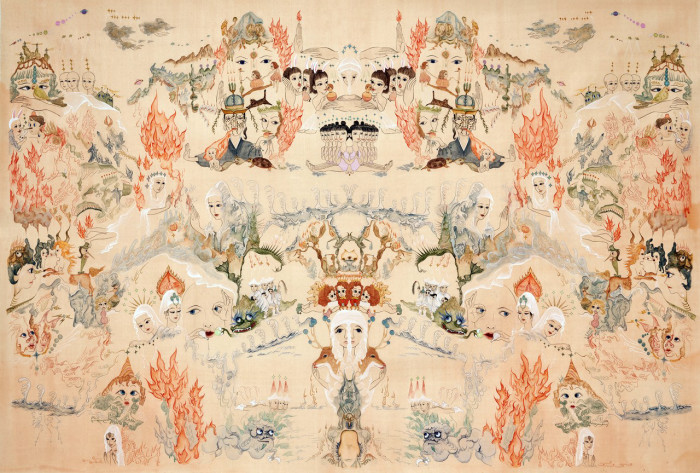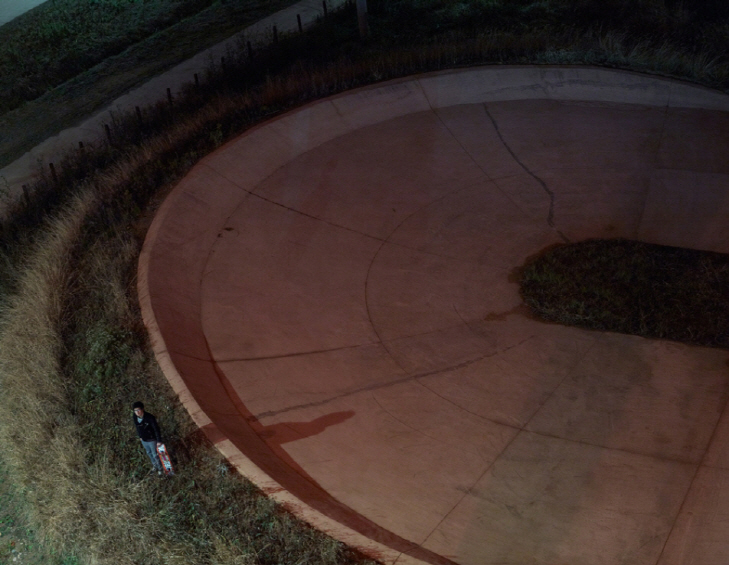“When
I showed you my work before, you said you wanted to write something. I know the
schedule’s a bit tight, but I wanted to talk to you about it.”
“Me?”
Hmm. I couldn’t really remember.
“Yes.”
His response was assertive.
He
must have been showing me artwork for an exhibition, and that’s what I had told
him.
It
seemed a lot different from his earlier work, but it somehow felt similar in
its context.
I
was drawn to the recklessness of something that must have been impossible from
the outset? something different the sort of photography that captures facts and
places, something that attempted to capture time and the universe alongside
history.
And
yet…the pictures were pretty, but they were also sad, painful.
He
titled the first of his star photographs Rifling. Referring to the helical
groove in a gun barrel, rifling is said to cause the bullet to gain rotational
inertia and a stable trajectory as it rotates along the spiral. Interestingly,
Kim Taedong viewed the trajectory of movement in the photograph of stars as the
spiral of a bullet? as rifling. This leap from stars to bullets seemed like
something of a stretch, but as I heard him describe it, I sensed how the stars’
path might appear similar to rifling.
It
also occurred to me that what led him to so naturally make the leap from a
star’s pattern to bullets may have been the story behind where the photograph
was taken. rifling-011, which could be called the first work in the Rifling
series, had apparently been taken in a wartime historic site on the grounds of
the Cheorwon Waterworks. The facts surrounding this area, which often appears
in discussions of the DMZ around Cheorwon, are still in dispute. Built in 1936,
the Cheorwon Waterworks were Gangwon Province’s first water facility. Some
claim the location was also used to detain Japanese collaborators during the
Korean War; others allege that over 300 people were shot or buried alive in
storage tanks amid the flight from the area during the northern advance. It is
difficult to confirm what the truth is, but it isn’t hard to imagine that the
events that took place here were by no means aromantic or happy tale.
I
imagined him coming here in the darkness after the sunset, with no one else
around, and setting his camera on a tripod to capture the stars. At any moment,
a wild animal could come springing out. A situation where nothing that happened
would seem strange, nothing could be predicted. All sorts of thought would have
come to mind as he stood out there in the middle of the night. He would have
waited there, alone, and looked up at the sky to find it filled with stars. The
atmosphere would have been damp and chilly. Seen amid that fear and terror, the
stars would have appeared so beautiful? and in the moment of admiration for
that beauty, there would have been no thoughts of anxiety or tension.
With
its shining stars, the photograph was quite beautiful, gently capturing the
gaze, yet I kept feeling my heart lurch in my chest? a fact that did not seem
due to the “rifling” title alone. There were the glimpses of war memorials and
other monuments in the image, the settings that those traces called to mind,
the scars of war, the division of a nation. Had it not been Cheorwon, had it
not been the vicinity of the DMZ, had it not been a place marked by the scars
of wartime carnage and division, the stars would have told a different story.
This explains the gunshots and shouts that can be heard in the photograph’s
stars. The picture itself is quite tranquil and gentle, yet the viewer feels
stunned and uncomfortable. If one were to suggest that this stunned discomfort
was a mistake on my part, the result of overidentifying with the story conveyed
by the setting, I would have nothing to say to them. So itis with Kim Taedong’s
stars.
He
described the process of photographing the stars as having been difficult. The
hardest part, he said, was following the stars and fixing them in place. Kim’s
star photographs are not pictures that capture stars alongside some object that
appears in the image with them. Producing with something called an “equatorial
telescope,” they use long exposure times to track and fix stars in order to
capture them in the image. The aperture is kept open for the better part of an
hour, and the process of moving precisely with the stars is quite a bit
different from the typical “snapping” of photos. Not only that, but the artist
also said it was difficult to predict how the image would come out during the
tracking process. It might seem like a fool hardy approach indeed in an era
where we can push the shutter and instantly see the results. When he is lugging
over 100 kilograms of equipment to his setting, there is no actual guarantee he
will be able to work at all. Many times, he must have waited and waited until
daybreak, watching the weather and surrounding conditions change from one
moment to the next, until eventually having to return without a single shot.
So
the stars that appear in Kim’s star photographs are not the stars at the
“moment” the shutter was pressed. They are images of starlight, which has
traveled over hundreds of millions of light-years to arrive now on Earth. The
resulting images of stars, presented to us clear and unwavering by opening the
aperture and following their traces, are thus records of time? a time beyond
the scope of human experience. It is the image of the wavering object
underneath that starlight, at this moment. The wavering present under the stars
is all the more realistic for being unclear. Like a composite, a painting, the
wavering image conveys a subtle sense of tension, as the seemingly realistic
objects suddenly lose their temporality, seeming instead like a stage set.
Kim
Taedong’s star photographs have been come mainly as part of two series:
Rifling, which may be seen as the beginning of his work with stars, and
Planetes. They differ in the relatively stronger or weaker emphasison war or
historical imagery, but they share a common grain in being records of “star
time.” The most interesting thing about the works in these two series may be the
unseen, dynamic movement that arises in the viewer beholding the photographs.
This is one of the elements setting Kim’s star work apart from other
photographs: even though it is a two-dimensional photographic image, it creates
a temporal and spatial flow in which the gaze of the viewer looking upon it
becomes either expanded infinitely beyond the image or compressed in front of
it. Just as things seem to be blurring as we focus on the stars, some objective
information enters our gaze? evidence of history, such as the Korean War and
its associated monuments. Our attempts to focus sentimentally on the romantic
motif of the “star” are frustrated by the marks of information captured within
the gaze. Just as our gaze is ready to expand out into the vast reaches of the
universe, a wavering image of the object drags it into the present. At first
glance, the image seems quiet and peaceful, but the movement of the gaze within
that image is more dynamic than in any other picture, a warlike back-and-forth
between reason and feeling. He seems simply to have photographed stars, yet the
images allow for an odd experience where we are struck by some kind of vague,
weighty emotion that cannot be put precisely into words. These are the star
photographs of Kim Taedong.
When
I first heard from Kim about his Rifling series of starimages, it seemed a bit
random to me? why stars all of a sudden? Looking at this earlier Day Break
series, showing the unfamiliar people encountered late at night or early in the
morning while the city is sleeping, or Break Days, depicting the sub-center of
Seoul where he has long been living, I had imagined that he would continue on
like other young photographers, showing stories of daily life and in the city
within a similar context. Yet when I think back on it now, the potential for
his star work may have been there from the time of Day Break. Night in the city
wears a different face from the day. City night scan be brighter than the day,
looser and sometimes sadder. It is a time when the barriers we just manage to
sustain can loosen up. While he was working, the artist would make his way
through the city night like a hunter or fleneur; to him, night was familiarity.
Never mind the dazzling lights? the stars were there, in the night sky.
It
may have been this familiarity with the night that allowed him to venture out
to the waterworks with his camera in the middle of the night for the Real DMZ
project. But the night that he encountered in Cheorwon? night in a place where
the traces of history are still very much present ? may have had a different
face to it. He may also have been entranced by the stars that were not visible
in the city. In any case, I had the sense it may have been a natural process
for him to open up his camera’s aperture to the stars.
Planetes
is the title chosen for this exhibition, which includes works from the Rifling
series (the star of Kim’s work with star) and the subsequent Planetes series.
The name “Planetes” was taken from the title of a Japanese anime work telling
the story of Hoshino Hachirota and his crew, who clean up debris around the
Earth caused by rampant space development. Taken from the Greek, planetes is
said to mean something like “wanderer” or “traveler.” Did Kim see something of
the planetes in himself as he set out at night with his equipment to photograph
stars? Did he see the planetes in his own inability to come out with any
definite answers amid the reality of Korean history and society that he
confronted as he photographed those stars? Perhaps he saw himself in the image
of Hoshino wandering amid ideals and reality, cleaning up space debris as he
goes.
Kim
Taedong’s travels and wandering are still going on. While Planetes was begun as
a work connected with the Korean War commissioned by the Australian War
Memorial, it also seems to have served as turning point allowing his work with
stars to move beyond its “war” and “history” framework and get at a more
fundamental approach. Looking at the photographs in the Planetes series, one
senses how the connection with the “star” and “war” motifs is somewhat looser.
PLANETES Project, AU 005, a night image of Canberra taken when the artist
happened to encounter a sea of clouds while working there, sticks with me as
something akin to both an ending to this exhibition and a beginning for the
next. Showing the lights of the city wavering against a blue-tinged night sky
filled with stars and a sea of clouds stretching out underneath, the photograph
seems to suggest what awaits him now: a time not for seeing through the stars,
but seeing the stars as they are.
Having
returned to the city, he will continue to work there.
But
perhaps his perspective on the city has changed.
There
are stars in the city too.
And
when you look, there were stars every place he had been.




















